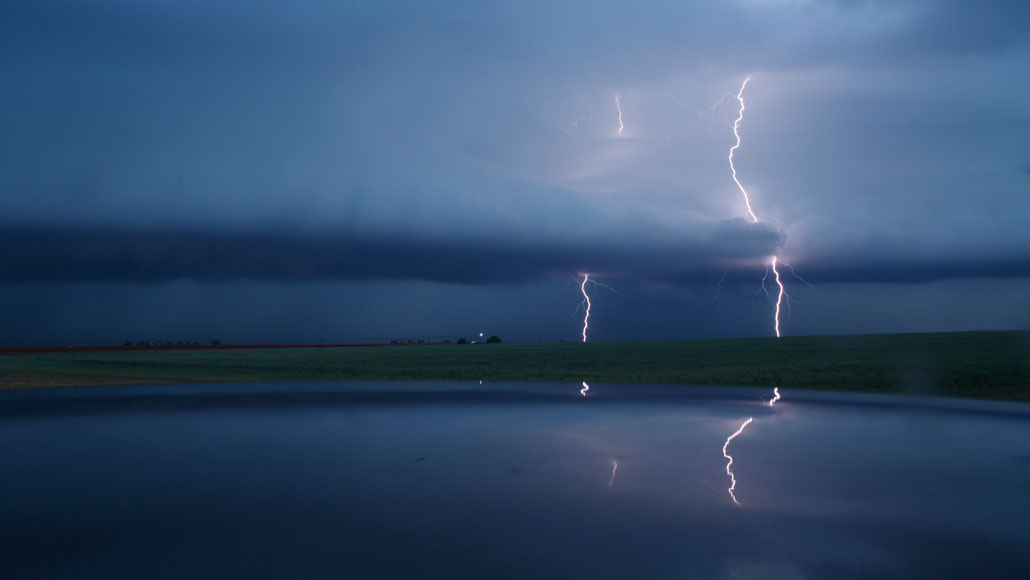atmosphere: The envelope of gases surrounding Earth or another planet.
chemical: A substance formed from two or more atoms that unite (bond) in a fixed proportion and structure. For example, water is a chemical made when two hydrogen atoms bond to one oxygen atom. Its chemical formula is H2O. Chemical also can be an adjective to describe properties of materials that are the result of various reactions between different compounds.
climate: The weather conditions that typically exist in one area, in general, or over a long period.
climate change: Long-term, significant change in the climate of Earth. It can happen naturally or in response to human activities, including the burning of fossil fuels and clearing of forests.
cloud: A plume of molecules or particles, such as water droplets, that move under the action of an outside force, such as wind, radiation or water currents. (in atmospheric science) A mass of airborne water droplets and ice crystals that travel as a plume, usually high in Earth’s atmosphere. Its movement is driven by winds.
concentration: (in chemistry) A measurement of how much of one substance has been dissolved into another.
dissolve: To turn a solid into a liquid and disperse it into that starting liquid. (For instance, sugar or salt crystals, which are solids, will dissolve into water. Now the crystals are gone and the solution is a fully dispersed mix of the liquid form of the sugar or salt in water.)
electricity: A flow of charge, usually from the movement of negatively charged particles, called electrons.
forge: (noun) A furnace or shop where metal is worked and turned into new materials. (verb) To shape metals under heat and/or pressure, or (colloquially) to form one element from another under the intense heat and pressure inside stars.
hydroxyl radical: A molecule (OH) made from a bound hydrogen and oxygen atom. It has two half-filled covalent bonds, meaning each seeks an electron. This makes the molecule highly chemically reactive.
lightning: A flash of light triggered by the discharge of electricity that occurs between clouds or between a cloud and something on Earth’s surface. The electrical current can cause a flash heating of the air, which can create a sharp crack of thunder.
methane: A hydrocarbon with the chemical formula CH4 (meaning there are four hydrogen atoms bound to one carbon atom). It’s a natural constituent of what’s known as natural gas. It’s also emitted by decomposing plant material in wetlands and is belched out by cows and other ruminant livestock. From a climate perspective, methane is 20 times more potent than carbon dioxide is in trapping heat in Earth’s atmosphere, making it a very important greenhouse gas.
molecule: An electrically neutral group of atoms that represents the smallest possible amount of a chemical compound. Molecules can be made of single types of atoms or of different types. For example, the oxygen in the air is made of two oxygen atoms (O2), but water is made of two hydrogen atoms and one oxygen atom (H2O).
NASA: Short for the National Aeronautics and Space Administration. Created in 1958, this U.S. agency has become a leader in space research and in stimulating public interest in space exploration. It was through NASA that the United States sent people into orbit and ultimately to the moon. It also has sent research craft to study planets and other celestial objects in our solar system.
nitric oxide: A potentially toxic chemical (NO) produced by the combustion of fossil fuels or by lightning. NO can play a role in the formation of smog ozone, a potent lung irritant.
pollutant: A substance that taints something — such as the air, water, our bodies or products. Some pollutants are chemicals, such as pesticides. Others may be radiation, including excess heat or light. Even weeds and other invasive species can be considered a type of biological pollution.
radical: (in chemistry) A molecule having one or more unpaired outer electrons. Radicals readily take part in chemical reactions. The body is capable of making radicals as one means to kill cells, and thereby rid itself of damaged cells or infectious microbes.
trillion: A number representing a million million — or 1,000,000,000,000 — of something.








